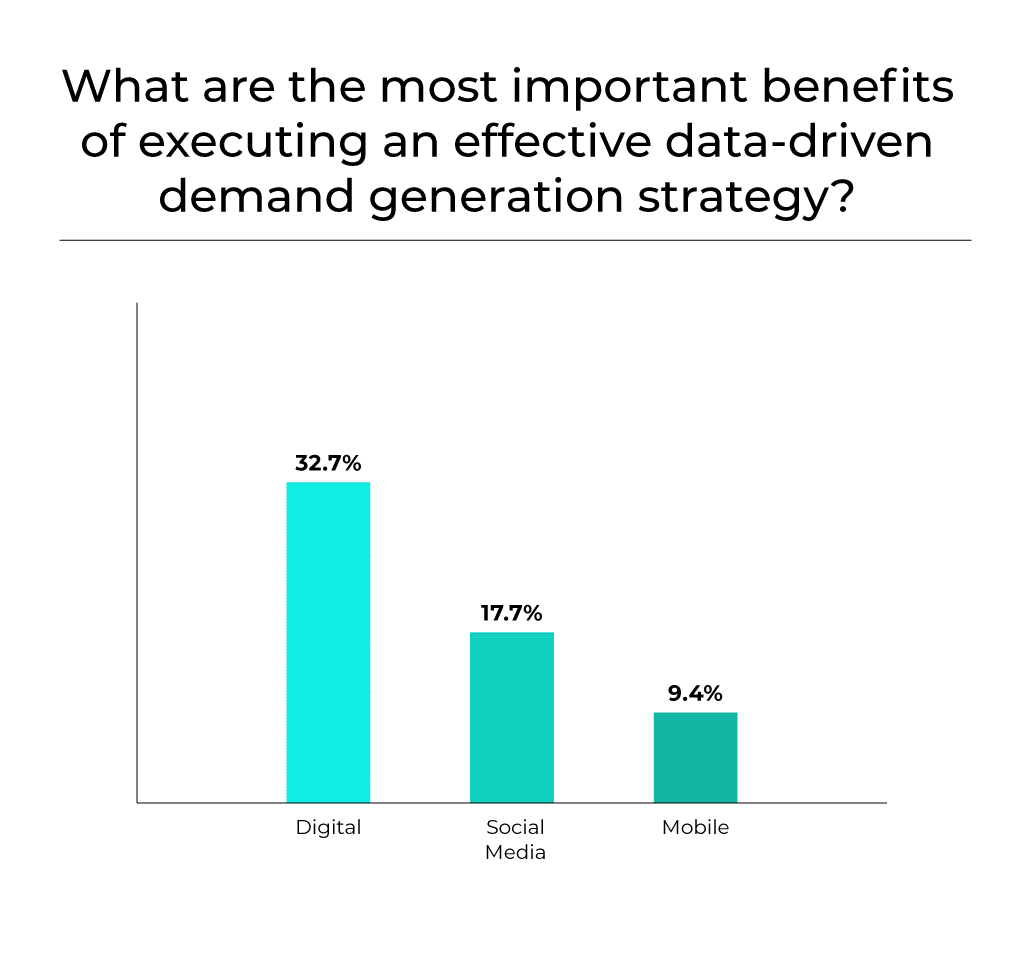SaaS Marketing Guide
What is SaaS marketing? 12 proven tactics to create and execute your own strategy
Book a FREE SEO Strategy Consultation >
Further Reading:
- SaaS Marketing Strategy
- SaaS Content Marketing
- SaaS SEO
- SaaS Account Based Marketing
- SaaS Email Marketing
- SaaS Inbound Marketing
- SaaS Retargeting
- SaaS Marketing Budget
- SaaS Marketing Plan
- SaaS Referral Marketing
- SaaS Demand Generation
- SaaS Customer Journey
- SaaS CMO Strategy
- SaaS link building
- SaaS Lead Generation
- SaaS Landing Page Examples
- SaaS CMS
- SaaS Customer Churn
- SaaS Marketing Automation
- SaaS Marketing Campaigns
- SaaS Marketing Agency
- SaaS SEO Agency
- SaaS Link Building Services
Finding the right SaaS marketing strategy for your company may seem challenging, but in such a competitive environment, it’s crucial.
It’s estimated that the total value of the worldwide SaaS market will hit $195 billion in 2023, up 17% from 2022. With the sector enjoying rapid growth, there are plenty of opportunities out there. Nevertheless, to stay one step ahead of the field, you’ll need a watertight SaaS marketing plan.
Marketing of any kind is all about finding ways to stand out from the crowd. To achieve this, it’s vital to understand who your potential customers are, where to find them, and how to engage with them in a way that works.
However, it’s not enough to use a standard B2B marketing strategy. There are a number of elements of the SaaS business model that are quite specific, so the marketing mix you use to promote your product needs to be tailored to fit.
We’re going to explore 12 SaaS marketing techniques that have been tried, tested, and proven to be very effective.
Here’s a quick look at what we’ll be covering:
How is SaaS marketing different?
Why do B2B companies need SaaS marketing?
Tactics in creating an effective SaaS marketing plan
- Utilize content marketing
- Spend time on your site’s SEO
- Invest in paid searches or PPC
- Undertake intelligent referral marketing
- Generate industry exposure
- Limit customer choice
- Don’t be coy about pricing
- Offer free trials and/or a freemium model
- Make it easy to sign up
- Enhance user experience
- Introduce deals and discounts
- Utilize clear CTAs
Real life examples in SaaS marketing—and how they did it
- SEO – RingCentral
- SEO – Global App Testing
- Email marketing – Kissmetrics
- Content marketing – Wistia
- Freemium – Slack
- Referral marketing – Dropbox
Are you ready to put it all together?
What is SaaS marketing?
In one sense, SaaS marketing is similar to other kinds of traditional marketing—it’s about targeting potential customers across one or more channels with a view to growing your sales. What marks it out as slightly different is the nature of the product.
Firstly, it’s intangible. You can’t pick a SaaS product off the shelf at a grocery store or receive it in a parcel by mail. It’s a purely digital item, so the marketing strategy focus also has to be on using digital channels in a range of ways, from SaaS email marketing to content marketing.
Second, the pricing structure is designed to generate continuous revenue. You’re not selling software as a one-off purchase but rather with an all-in ongoing service model.
That means customer retention is just as important as customer acquisition, so your marketing efforts can’t afford to ignore your existing customers.
Overall, companies spend 58% of their marketing budgets on digital marketing—but that rises to 89% for businesses that sell entirely online.
How is SaaS marketing different?
Product
Marketers have to get creative when promoting a SaaS product. As we mentioned, most, if not all, SaaS products are intangible. On top of that reality, SaaS products can be complex, with lots of different features.
Your SaaS marketing strategy needs to be catchy and simple, yet still informative enough for the target audience to grasp the product’s ability to solve their problems.
Customer
While there are exceptions, most customers you’ll be targeting with your SaaS product will be B2B and B2C companies. That means you need to persuade the people who make the decisions that your solution is the right one for their organization.
If you’re offering a CRM solution, for example, it would make sense to approach the directors of sales departments at B2C companies.
Once you’ve attracted customers, you’ll need to make sure you keep them. As we’ve already mentioned, retaining customers for the long term is a fundamental part of any SaaS business model. So, another important goal will be reducing customer churn. It’s wise to dedicate a proportion of your marketing efforts to ensuring your existing, long term customers are happy.
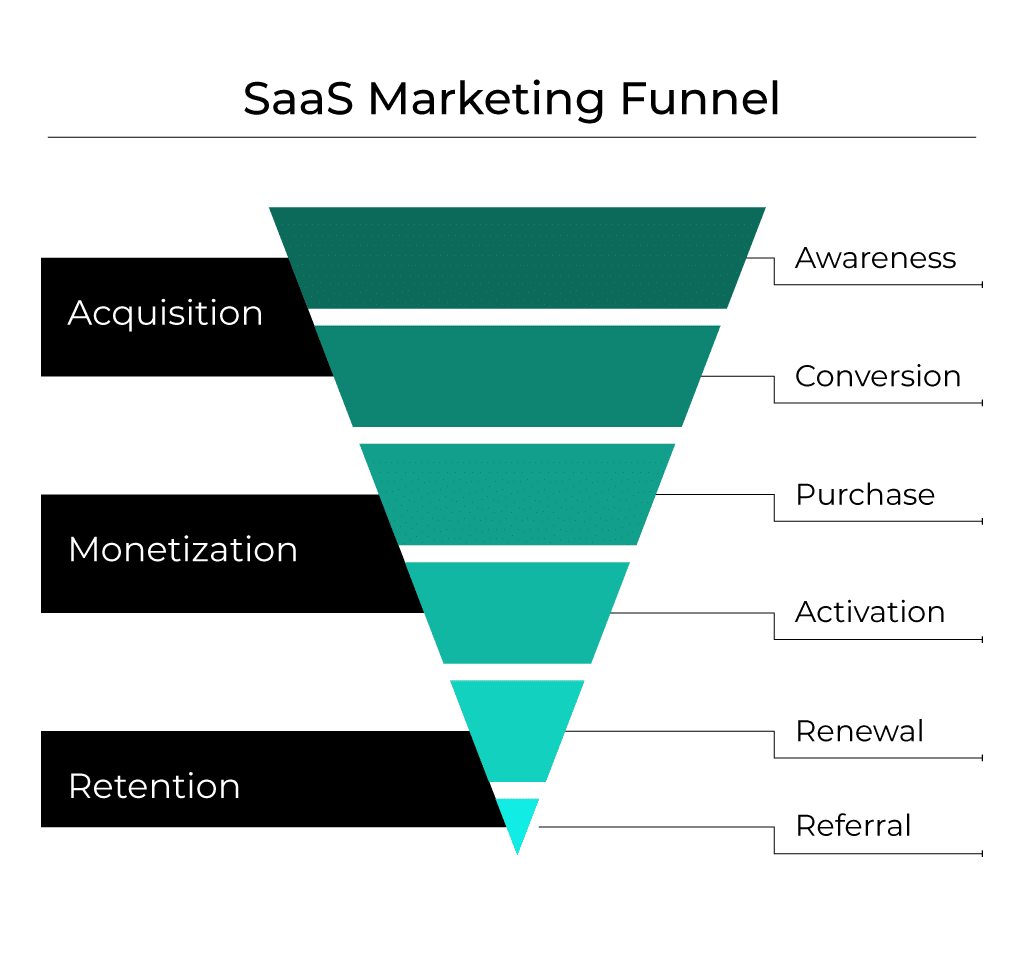
Customer journey
When organizations are considering buying a SaaS solution, it’s usually not a quick decision. Often, integrating that solution requires a reassessment of their business processes, and they’ll want to do their due diligence first to make sure your service would be a good fit.
That means your marketing efforts have to take this into consideration. You can expect your potential customers to ask for detailed information, as well as a demo or trial of your service to explore whether it would function well with their existing systems.
Because of this, sales cycles tend to be longer in the SaaS sector than in many others, making some traditional marketing methods less well suited.
Competition
According to Statista, there were approximately 17,000 SaaS companies in the US in 2022. That’s a lot of competition! Making your business stand out from the crowd isn’t easy, but it can be done.
The first item on the agenda is to make sure you’re offering the highest quality product possible.
Assuming you are, the next thing to focus on is your branding. From there, you can develop a digital marketing strategy that includes the right mix of SEO, content marketing, and other SaaS-friendly techniques.
Pricing
In such a competitive market, everything feeds into your SaaS marketing strategy—and that includes your pricing.
Make sure you tailor your pricing model to your target market. If your service is mostly aimed at small businesses, affordability may be a much more important element of your pitch than it would be if you were targeting large corporations, for example. And don’t overlook a tiered pricing structure as an option, as it can be very effective.
Clarity and detail are key. Making sure you explain exactly what your customers will be getting for their money is the best way of achieving conversions.
Why do B2B companies need SaaS marketing?
B2B SaaS marketing comes in many flavors, but it’s a critical contributor to success, whatever the details of the strategy might be.
Being in the SaaS business poses specific challenges. As we’ve established, it’s a highly competitive sector.
In some fields, you may find yourself competing against one or two established operators that dominate the market. If that’s the situation you’re in, establishing or growing your own presence in that area can seem like a tough task.
On the other hand, you might be operating within a small niche. In that case, finding the right channels to communicate on and engage with your narrow target market can bring difficulties of its own.
In any event, the nature of SaaS involves continuous evolution. To stay relevant, you need to constantly upgrade and improve your offering, adding new features and functionality.
Your marketing needs to work hand in hand with the realities of the software development cycle within the context of your area of business.
The good news is that there’s always an answer. With the right expertise on board, you can develop the ideal SaaS marketing strategy for your organization. And no matter what service your business provides, investing your SaaS marketing budget wisely will help you achieve your goals.
Tactics in creating an effective SaaS marketing plan
There are two main parts to marketing a SaaS product. First, you have to get as much organic traffic to your site as possible. Then, you need to promote and show off your service effectively.
We’ve arranged our tried and tested SaaS marketing strategy points into two sections—firstly, getting more traffic to your SaaS site and then converting that traffic into sales:
Generate more site traffic
These are five tried and tested ways to get more traffic to your SaaS site:
1. Utilize content marketing
Content marketing is a great avenue for lead generation for any SaaS website, as—when done well—it brings people back again and again.
For this to work, you need to publish high-quality content that aligns with the interests of your target audience. For example, if you had a Facebook marketing SaaS tool, suitable topics for your content could include:
- Best Facebook marketing tactics
- Facebook marketing for SaaS companies
- How to use Facebook marketing for your startup
- Using influencers in your Facebook marketing plan
The list of suitable topics you can choose is extensive. You can use a tool like Keywords Everywhere to identify suitable topics to write about based on search volume:
You need to optimize the content you create on your blog for both user intent and keywords. This means any content you add should answer a query or resolve a pain point someone has been researching.
If they’ve come through a Google search looking to purchase a service, they’ll want to see a sales page. On the other hand, if they undertook an informational search, they’ll probably prefer to land on a blog post.
It’s important to understand where in the sales funnel these potential customers are coming in, and having the right content available. That could be a landing page, detailed case studies, general blog posts, or something else.
It’s not enough to simply have great content, however, you need to generate backlinks to the content for it to rank. To understand how many backlinks you need, you will have to do a backlink analysis of ranking content. Once your content starts getting noticed your business will develop a reputation as an authority in the SaaS industry.
Writing content is time consuming, especially for a sales team who are working on other tasks. This is an area worth seeking out partnerships or SaaS SEO companies for, as it will save you a lot of time in the long run.
2. Spend time on your site’s SEO
Nothing works as well for boosting site traffic as a comprehensive SEO strategy. Search Engine Optimization (SEO) is complex and goes hand-in-hand with content marketing.
The basic idea is a simple one: You tailor a site so that it appears as high as possible on search engine results pages. The higher your site ranks, the more traffic you’ll get.
There are a vast number of tactics which combine to make for good SEO. Some SEO tasks and efforts work better for SaaS sites than others. For now, it’s enough to note that investing in top-quality SaaS SEO will do wonders for your site traffic.
3. Invest in paid searches or PPC
Paid search or pay per click (PPC) advertising is another avenue worth exploring.
As a SaaS marketing strategy, you shouldn’t see it as an alternative to content marketing and SEO. What it can be, though, is an excellent compliment to those two processes. Particularly if you’re looking to achieve some quick traffic wins.

You should always set aside a marketing budget for branded search terms (terms that include your company name). Branded search terms are results that competing software companies are likely to pay for, and if they do, then you need to have a budget to get those clicks.
If you do invest in PPC ads, you want to get as much bang for your buck as possible, keeping the customer acquisition costs low. Your marketing team needs to create engaging and attractive adverts that convey your service’s benefits.
The best way to improve the conversion rate of your ads is by repeated testing. Create lots of variations of ad copy, research plenty of keywords to target, and monitor metrics. That way, you can mix things up and experiment until you find the right combination.
4. Undertake intelligent referral marketing
Referral marketing is like the digital equivalent of word of mouth advertising. It involves getting current customers to recommend your service to people they know, both privately or publicly on platforms like LinkedIn.
It’s an effective SaaS marketing strategy, as it increases the chances of bringing in qualified leads, who will already have a level of trust in your business thanks to the recommendation. This is particularly helpful for B2B SaaS brands, who are less inclined to make impulse decisions.
That said, even your most satisfied customers may need a little push to refer you to friends. This is where a referral program with smart incentives or rewards enters the picture.
Offering access to an extra feature or a higher level of your software in return for a referral is a good example. Dropbox, for instance, gives users extra storage space if they invite friends.
5. Generate industry exposure
People put a lot of stock in reviews and testimonials. A BrightLocal study found that 91% of 18-34-year-olds trust online reviews as much as personal recommendations.
It’s critical to get your SaaS business industry exposure on one of the many SaaS review sites which are around. G2 Crowd and Capterra are perhaps the best examples.
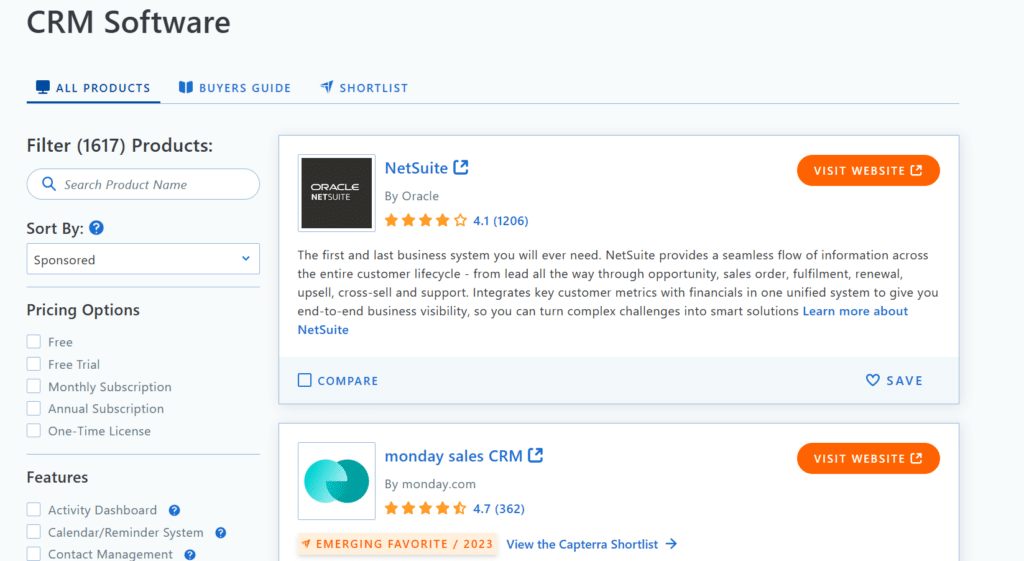
Getting a positive review on a review site will help with site traffic, so it’s worth trying to get a listing on as many review sites as possible.
You may not get featured by all of them, but it’s worth a try. Having a (positive) presence across sites helps provide social proof and convince potential customers of the viability of your business.
How to sell your service
The next stage of marketing SaaS is to turn website visitors into customers. We’ve put together seven hints and tips for improving this part of your digital marketing strategy:
6. Limit customer choice
At first glance, this piece of advice may seem counterintuitive. Surely you want to offer SaaS customers as many different options as possible? Actually, no. It is better to limit the range of options as this makes it easier to choose.

The email marketing software platform, Mailchimp is a good example. Their software provides users with loads of different features. However, there are only four separate plans to choose from, each with clear value propositions.
Prospective customers can see what each one offers and choose between them, rather than getting overwhelmed and looking elsewhere.
7. Don’t be coy about pricing
Some SaaS businesses make it difficult for site visitors to see how much their service costs. The idea is presumably to get visitors more interested in the service before revealing the price.
However, it can hinder customer acquisition, as a lack of transparent pricing can be frustrating. Think about when you head to a site thinking of buying something. What would your response be if you can’t see how much it costs?More often than not, you’d leave the site and find somewhere else to make your purchase.
This can be a massive source of churn. SaaS marketers need to take this into account. Hiding or obfuscating prices makes prospective customers suspicious, no matter how good the rest of your marketing efforts are.
Instead, be open about the cost of your service. Make sure that your pricing strategy makes it easy to show how each plan or package delivers value.
8. Offer free trials and/or a freemium model
Free trials are a mainstay of SaaS marketing. You’ll struggle to find a SaaS business that doesn’t offer one. That’s because free trials are hugely effective in selling SaaS products.
From CRMs to VoIP, a free trial helps users understand how your software works, and specifically, how it can solve their problems. That’s why leading SaaS companies like Xero feature free trials so prominently on their sites:
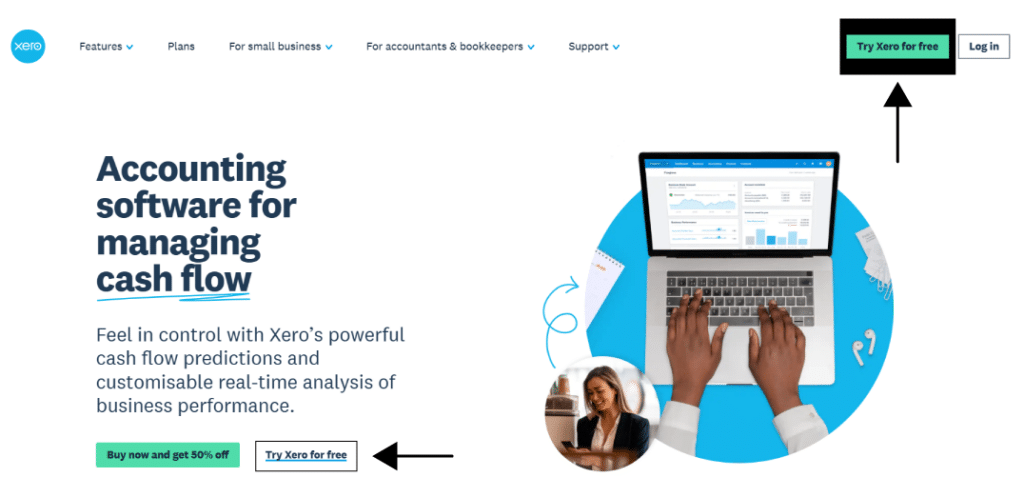
Alternatively, you could work on a freemium model. This provides the customer with a free version forever, but they have to be paying subscribers to access many of the features. This model means you’re giving customers a taste of the benefits they’ll get by signing up, as well as encouraging them to rely on your product before deciding to invest in extra features.
9. Make it easy to sign up
Speaking of signing up, doing so should be as quick and easy as you can make it.
You’ve run great marketing campaigns, and drawn people to your site. You’ve made sure your website sells your service and makes it sound irresistible. And now, you’ve convinced a prospective customer to sign up!
At this point, a long and complicated signup form is a no-no. People often abandon these when they’re faced with them, even if they had every intention of signing up.
Make sure your onboarding process is clean and efficient. Don’t ask for information that isn’t critical to getting a new customer registered. Give those prospective customers as few excuses to change their minds as you can.10.
10. Enhance user experience
So far, we’ve talked at length about marketing and selling your software. About how to make potential customers aware of it and to best persuade them of its benefits. It’s important to remember that there is another “S in SaaS.
The second “S” is for service, and delivering excellent service to customers is critical for customer retention.
Unless you’re incredibly lucky (or incredibly talented!), your software will be somewhat similar to that of other firms in your niche. In order to maximize customer lifetime value, you need to find a way to differentiate yourself.
First, show customers how your software will improve their life or their business in your marketing material. Second, ensure it actually does so, by making your customer service top-notch.
As well as the product being great, make sure to offer a fantastic user experience every time a customer interacts with your firm. Host webinars, share templates, and provide informative guides or white papers. The user experience isn’t just about their interactions with your product. It’s about interactions with your brand.
11. Introduce deals and discounts
Deals and discounts can be crucial to your SaaS marketing strategy. Offers can help show prospective customers that they can get higher value with you, and they’re also great for upselling and cross-selling.
While you can profit from running deals and discounts, make sure you only run them on occasion or when certain terms are met (for instance, on first sign up). If people are offered discounts all of the time, they stop perceiving them as a special offer. Instead, people will view these deals and discounts as the regular price they expect to access.
12. Utilize clear CTAs
You should organize your site in a way that makes moving around it as frictionless as possible. The process of becoming a customer should be as easy as it can be.
Incorporating clear calls to action (CTAs) into your content marketing strategy can help with this. Take the below example of the Mailchimp website:
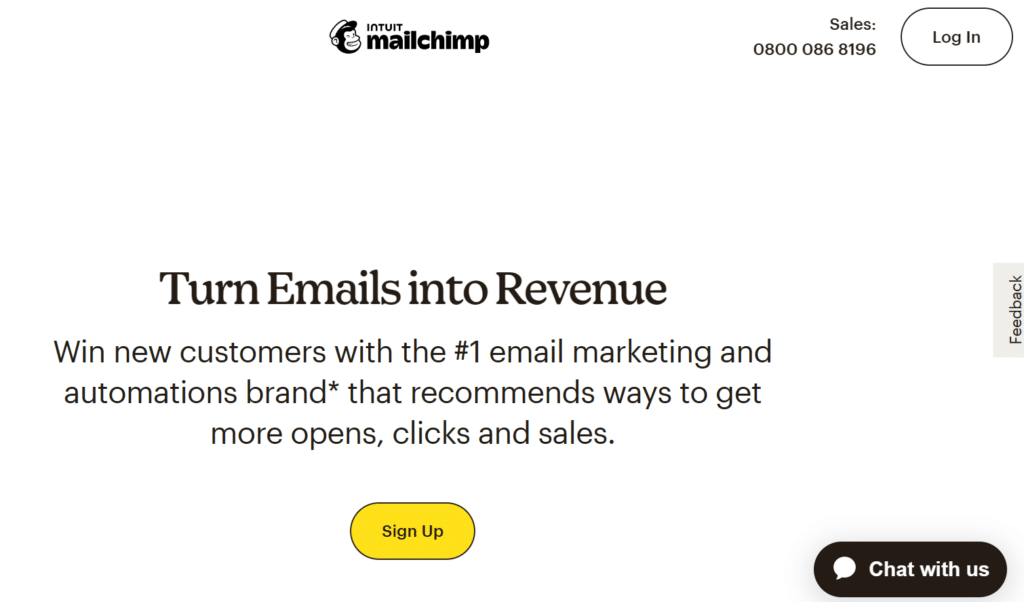
This page makes a visitor’s next steps clear. They can choose to “Sign Up”, “Log in”, or “Chat with us.” The explicit anchor text and prominent positioning of the CTAs are key, as they encourage users to progress through the site. Almost before they realize it, they’ll find themselves at the point of signing up.
Real life examples in SaaS marketing—and how they did it
Wondering how these SaaS marketing strategies translate into real life? Let’s take a look at some examples:
SEO – RingCentral
RingCentral is a heavy-hitter in the global cloud communications solution game, not to mention an eight-years-in-a-row Gartner UCaaS (Unified Communications as a Service) Magic Quadrant leader.
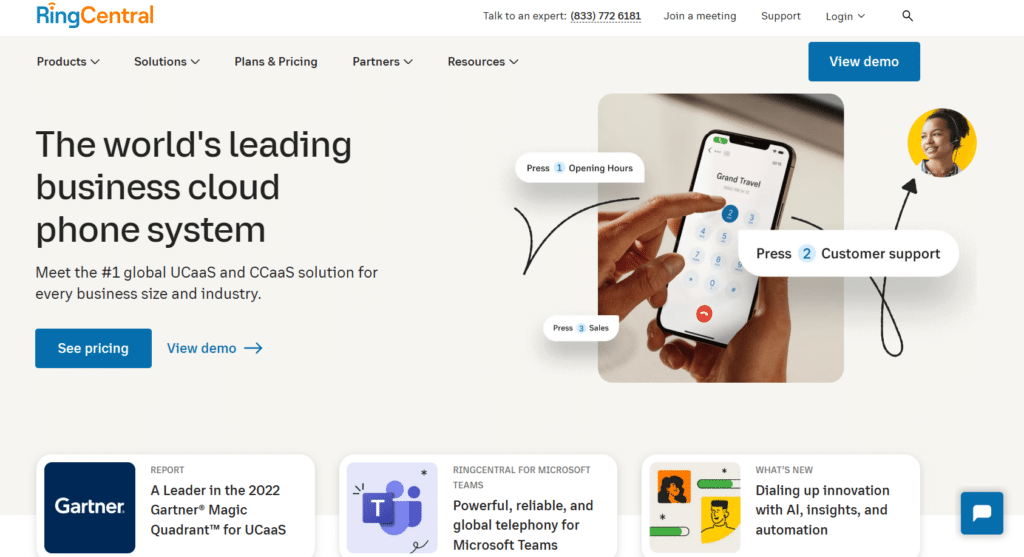
Despite these successes, RingCentral still felt the strain of a crowded UCaaS market. They wanted to expand their core service offerings in the US, UK, French, and German markets, while increasing organic traffic and non-branded traffic to their website.
How did they achieve this? By using digital marketing to focus on building their on-site content.
On-site content
RingCentral’s existing content failed to address an audience considering their products or potential customers ready to buy. To remedy this, they employed a new SEO strategy using customer-centric, targeted content.
More than 200 pages on their website were optimized with new and emerging keywords. Content hubs were created to segment visitors by audience, funnel phase, and search criteria, so relevant content was promoted during initial searches and throughout the customer journey.
A link-building strategy was used to match RingCentral with over 5,000 high-authority domains and publications, with daily visitors adding up to more than 100 million. Not a bad start.
Blogging
RingCentral also decided to overhaul its blog content by revamping existing onsite articles. On top of that, they produced over 100 new articles for their blog, all geared towards attracting new visitors. Finally, they produced more than 700 pieces of offsite content. All in all, their efforts resulted in approximately 600K words.
And the result of these efforts? An 1185% increase in non-branded traffic and a 291% increase in overall website traffic value. In total, RingCentral (with some digital marketing assistance) achieved over $180 million in leads generated by SEO, 3.5 million additional visitors, a 40% increase in ARR and an ROI of 120:1.
SEO – Global App Testing
Global App Testing provides functional end-to-end testing solutions using crowdtesting and intelligent automation to help its clients deliver best-in-class software applications.
It was looking to raise its profile in the US and UK markets, and achieved spectacular results by vastly improving its search visibility.
Content marketing
To boost its own website’s domain authority, Global App Testing embarked on a project of securing content opportunities with suitable publications.
It placed top-quality thought pieces on high-authority sites such as venturebeat.com and Ispsystem.com, which resulted in over 1,300 backlinks to its own domain over a 12-month period.
Website optimization
In addition, the company added 30 new pages of content to its site, and streamlined its list of targeted keywords. It also produced a number of in-depth guides containing business-critical keywords, which enabled it to surpass those among its competitors who had previously been dominating the search results.
With this well-targeted marketing strategy, Global App Testing managed to increase its global monthly traffic value by 426% and monthly organic clicks by 250%.
Email marketing – Kissmetrics
Kissmetrics, an analytics product that helps to improve business metrics, needed to distinguish itself from one of its competitors, Google Analytics.
Competing against a free service—and one with a well-known brand attached—was no easy feat, but Kissmetrics achieved impressive results with the following email marketing tactics:
Segmentation and audience targeting
Kissmetrics used its own tools to analyze and segment its existing customers and potential customers. With new, different target audiences in mind, they focused on promoting product growth and getting their name out there.
Exclusive content and free trial
To get people interested in their brand, they developed a unique content strategy. By signing up with an email, anyone could receive an exclusive content gift and a free trial of their product.
These efforts paid off, and Kissmetrics saw an increase in their email subscriptions, becoming one of the top paid analytics products on the market.
Content marketing – Wistia
Wistia, a SaaS company that helps businesses achieve marketing goals through video content, used content marketing to develop a marketing campaign that highlighted their product while generating word-of-mouth buzz about their business.
Video series
Wistia won two Webby awards for their innovative series, “One, Ten, One Hundred,” in which they challenged an LA-based video production company to develop three different videos at three different price points ($1,000, $10,000, and $100,000) to see how budget affects creativity.
In total, they spent $111,000 on ad production for this video series and reaped the benefits of their ingenious content marketing idea.
Podcasts
When Wistia tried to get into the podcasting game by launching their own shows, they kept running into issues with podcasting software and distribution. So, they decided to create their own.
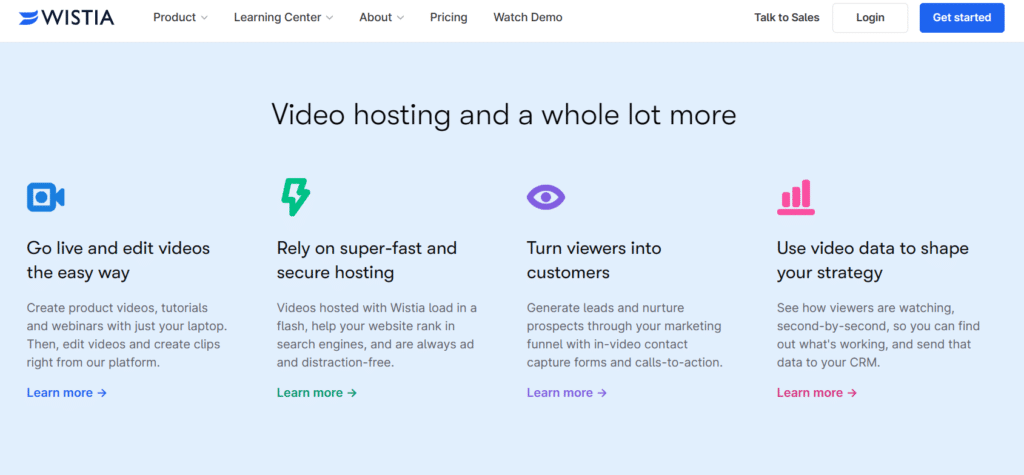
By solving a problem for their own content, they created a solution for their customers, who can now seamlessly create video and podcast content with Wistia’s podcast creation software.
Scoring system for content
To make sure their content marketing is top-notch, Wistia implements a scoring system for content, so only the best ideas get produced. That’s how they come up with award-winning content, keeping things innovative and fresh.
Freemium – Slack
How many advertisements have you seen for Slack? You might be tricked into thinking you haven’t been paying attention, but actually, they rarely advertise.
They’ve gained ground as one of the most popular SaaS products through word-of-mouth. Let’s take a look at how they did it.
Irreplaceable product
Slack started by offering a Freemium version of their full product that wasn’t watered down. Their product functioned so well in people’s work processes that once they started using it, they couldn’t imagine working without it.
They then doubled down and provided excellent customer service that couldn’t be beaten.
Once word spread in offices and on social media about Slack’s great product and great customer service, they were on their way to becoming a leading SaaS company.
Not time-based trial period
Slack’s other brilliant move was to offer their Freemium version on a message-based trial period, not a time-based trial period.
Traditionally, trial periods will last anywhere from 15 to 30 days, at which point a customer will need to upgrade. Slack based its trial period around messages, so when a company used up its allotted message capacity, they were notified that it was time for an upgrade.
At this point, a company would already be invested in the product and would upgrade—and that worked for Slack. Their conversion rate skyrocketed, and their customer lifetime value increased.
Referral marketing – Dropbox
Everyone is familiar with referral marketing. Saying “Refer a friend, and you get such-and-such off a future purchase” is an extremely popular way to bring in new customers. Dropbox took this to a new level with their wildly successful referral marketing tactic.
Embedded in onboarding process
Key to Dropbox’s success was embedding the referral process into the onboarding process in a fun, easy-to-use graphic.
Users can clearly see the progress they’re making towards free storage, and the well-designed page features a call-to-action to upgrade if they need even more storage.

Crystal clear terms
Dropbox lays it out clearly, and that’s important to their marketing success. By referring a friend, the user gets a certain amount of free storage. The more referrals you bring in, the more free storage you get.
One-click referral process
The final piece in the puzzle is the one-click referral process. Users can easily send a referral request to their contacts by adding emails or copying a shareable link.
Are you ready to put it all together?
So now you have 12 actionable steps and loads of additional information to help you achieve your SaaS marketing goals. Utilize all these tips or pick the ones that jump out at you the most—it’s your SaaS marketing strategy, and it should reflect your brand and your business.
Not sure where to start, or how to get the attention of your ideal customer? We can help you get started if you’re feeling stuck and make a tough job feel a lot easier.
